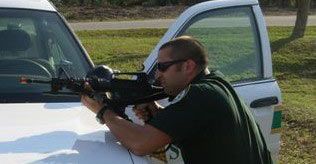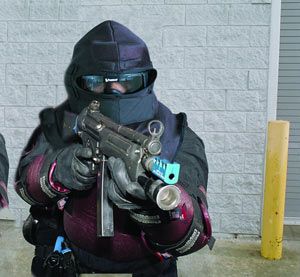By Dave Young
Marking your weapons for training is an important issue and a serious task — one that should never be taken lightly. Over the past 10 years, there has been an increase in officer-related deaths from shots with a live firearm during a training scenario.
|
|
There are three main reasons for marking your firearms when conducting training simulations:
- To give the person you’re firing at a level of comfort/knowledge that the weapon is safe and will not discharge a live round.
- To give the person handling and operating the firearm a level of comfort/knowledge that the weapon is safe and will not discharge a live round.
- To give a third-party onlooker a level of comfort/knowledge that the weapon is safe and will not discharge a live round — and that it’s being used in a training scenario.
Currently, there are no industry standards covering the issue. However, many trainers across the country are finding ways to make the training area safer. One way to do this is by using non-functional weapons.
Nonfunctional weapons can be made of plastics, injection molding, metal, aluminum, or other various solid constructions. Their specifications are as close as possible to real weapons, but are available in a variety of colors such as red, blue, orange, yellow, and even black (however, black is not recommended due to the possibility of the training weapon being mistaken for a real live firearm).
 Airsoft |
Non-functional weapons have no moving parts and aren’t capable of discharging a live projectile, which makes them completely safe. (Note that some may have sharp or intrusive areas, which, if they’re not filed, may cut the skin during defensive tactics.)
Another option for safe training is to use functional training weapons, which have come a long way from the toy plastic weapons of the past. For one, their specifications are close to the exact weight and size of real weapons. They’re made of the same materials as non-functional training weapons, but have actual working parts such as triggers, slides and safeties.
These are available in a variety of colors — usually black or silver — with a special marking on the slide or barrel that designates it as safe for training and identifies it as a functional training weapon and not a real firearm.
While functional training weapons do have moving parts, they are not capable of discharging a live projectile. They are designated with the color yellow as safe, with the markings on the barrel, slide and handle so they can be identified as a training weapon when secured in the holster.
 Air M4 with green laser xads redman gear |
Nonfunctional weapons are considered partially safe because they are able to discharge a training projectile at safe velocities and impact to the body. Training and special safety equipment is recommended, but they also may have sharp or intrusive areas, which may cut the skin during defensive tactics unless filed down or removed.
Technology has made it possible to convert your existing weapons so they can fire a training or marking round. These conversion kits make it possible for the officer to change their barrel and certain features of the top slide to accommodate a special training projectile with a marking tip.
It is important for the user to be trained and certified in these conversions so that proper and safe selection can be made. I recommend designating these converted weapons with the color blue, with colored tape on the barrel, slide and handle so it can be identified as a weapon converted to discharge a marking round when secured in the holster.
They are considered moderately safe as they can discharge a training projectile at safe to high velocities due to the various calibers used and impact to the body. Training and special safety equipment is recommended. Again, they may have sharp or intrusive areas, which may cut the skin during defensive tactics unless taped, covered, or removed.
Recommended reading: Training at the Speed of Life by Ken Murray https://www.police1.com/writers/columnists/KenMurray/articles/97999/













